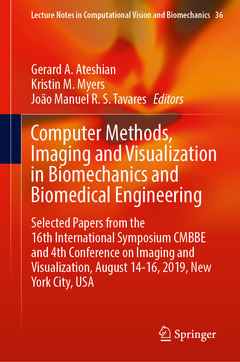Description
Computer Methods, Imaging and Visualization in Biomechanics and Biomedical Engineering, 1st ed. 2020
Selected Papers from the 16th International Symposium CMBBE and 4th Conference on Imaging and Visualization, August 14-16, 2019, New York City, USA
Lecture Notes in Computational Vision and Biomechanics Series, Vol. 36
Coordinators: Ateshian Gerard A., Myers Kristin M., Tavares João Manuel R. S.
Language: English
Subject for Computer Methods, Imaging and Visualization in...:
Keywords
CMBBE2019; Biomechanical Models; FEM Modeling; Muskoloskeletal Modeling; Soft Robotic Actuator; Artificial Muscle Control; Blood Flow Models; Non-linear Mechanical Behavior; Computational Models of Soft Tissues; Constitutive Modeling of Soft Tissues; Hyperelastic Material Models; Epithelial Tissue Modeling; Analytical Wear Modeling; Knee Wear Simulator; Aneurysm Hemodynamics; Hand Exoskeleton; Segmentation on Bioimaging; Medical Ultrasound Imaging; Reconstruction of Vascular Networks
657 p. · 15.5x23.5 cm · Hardback
Description
/li>Contents
/li>Biography
/li>Comment
/li>
Precise Mean Axis of Rotation (MAR) Analysis for Clinical and Research Applications.- Mathematical Model of Age-Specific Tendon Healing .- Classification of Elderly Fallers and Non-fallers Using Force Plate Parameters from Gait and Balance Tasks.- Creation of Categorical Mandible Atlas to Benefit Non-Rigid Registration.- The Effect of Non-Linear Spring-Loaded Knee Orthosis on Lower Extremity Biomechanics.- Consideration of Structural Behaviour of Bones in a Musculoskeletal Simulation Model.- Towards Particle Tracking Velocimetry of Cell Flow in Developing Tissue using Deep Neural Network.- An Index Finger Musculoskeletal Dynamic Model.- Accuracy of Anthropometric Measurements by a Video-based 3D Modelling Technique.
Gerard Ateshian is the Andrew Walz Professor of Mechanical Engineering and Director of the Musculoskeletal Research Laboratory at Columbia University in New York City. His primary research is in the field of soft tissue mechanics, with an emphasis on cartilage mechanics, lubrication, and tissue engineering, and the formulation of growth theories for biological tissues. In collaboration with Prof. Clark T. Hung at Columbia, he has translated his findings on cartilage mechanics to the field of functional cartilage tissue engineering, with a particular focus on the role of mechanical loading in tissue growth. Together with Dr. Jeffrey A. Weiss at the University of Utah, he has developed open-source computational tools that facilitate the modeling of tissue mechanics, transport, and growth processes (febio.org). He has applied and validated these tools with the modeling of engineered cartilage growth.
Kristin Myers is an associate professor in the Department of Mechanical Engineering at Columbia University in the City of New York. In 2010 she founded the Myers Soft Tissue Lab at Columbia, which uses experimental, theoretical, and computational mechanics to solve problems in Women’s Health and Reproductive Biomechanics. With clinical translation in mind, her lab is uncovering the structural antecedents of preterm birth. Her current obstetrics research is done in collaboration with the Department of Obstetrics and Gynaecology at the Columbia University Irving Medical Center. She received her Mechanical Engineering doctorate and master’s degree from Massachusetts Institute of Technology and her bachelor’s degree from the University of Michigan. In 2017 Kristin was given the American Society of Mechanical Engineers Y.C. Fung Young Investigators award for her contributions to the field of biomechanics, and in 2019 Kristin was awarded the Presidential Early Career Award for Scientists and Engineers (PECASE) for her work in unde
Reports on cutting-edge computational and imaging methods
Places special emphasis on biological and medical applications
Describes models for advancing biomedical engineering research




